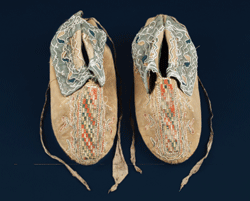
Bridge Street Cemetery Northampton Architecture Historic Markers 
|


Nonotuck
 |
| Moccasins, c. 1682, from the collections of Historic Northampton |
For Native Americans of Southern New England in the 17th century, life was centered in the village, a kinship grouping of extended families rarely numbering more than 300 to 500. There were no formal "tribes," but cooperation among villages took place when circumstances demanded. Yet there was a series of interconnected homelands spread along the entire length of the Connecticut River Valley. The Native American settlement at what is now Northampton was called Norwottuck, or Nonotuck, meaning: "the midst of the river." It consisted of a core area where clan meetings and elders' councils were held.
 |
| On September 24, 1653, “Chickwallop, alias Wawhillowa, Neessahalant, Nassicohee, Riants, Pasqualant, Assellaquompas and Awonusk the wife of Wulluther all of Nanotuck”, negotiated an agreement with the English for the land that became Northampton. |
As Europeans increasingly controlled access to the viable hunting, fishing and planting grounds, American Indians adapted as best they could. But it was an uneasy accommodation for all parties.
 |
| Wampum was produced and controlled by Native Americans and became a means of exchange in trade with Europeans. This example dates from 1660 and is on display at Historic Northampton Museum. |
Steady pressure from English settlements reduced the traditional homelands of Native Americans, and destroyed the populations of game and fur-bearing animals. The defeat of Metacom in King Phillip’s War of 1675-76 put an end to large-scale armed resistance to English settlement, but not to Indian habitation. Though many Native peoples sought refuge elsewhere, some never left their homelands, choosing to make themselves less visible by moving beyond the fringes of colonial settlements. This strategy of avoidance helped ensure a continued Indian presence in the valley up until the present day, but that presence often went unrecorded.
Contents Historic Northampton.